According to Philip Kotler, who is an economist and a marketing guru, a product is more than a tangible ‘thing’. A product meets the needs of a consumer and in addition to a tangible value this product also has an abstract value. For this reason Philip Kotler states that there are five product levels that can be identified and developed. In order to shape this abstract value, Philip Kotler uses five product levels in which a product is located or seen from the perception of the consumer. These 5 Product Levels indicate the value that consumers attach to a product. The customer will only be satisfied when the specified value is identical or higher than the expected value.
- Need: A lack of a basic requirement.
- Want: A specific requirement of products to satisfy a need.
- Demand: A set of wants plus the desire and ability to pay for the product.
Customers will choose a product based on their perceived value of it. Satisfaction is the degree to which the actual use of a product matches the perceived value at the time of the purchase. A customer is satisfied only if the actual value is the same or exceeds the perceived value. Kotler attributed five levels to products:
The five(5) product levels are:

-
Core Benefit
The fundamental need or want that consumers satisfy by consuming the product or service. For example, the need to process digital images.
-
Generic/Basic Product
A version of the product containing only those attributes or characteristics absolutely necessary for it to function. For example, the need to process digital images could be satisfied by a generic, low-end, personal computer using free image processing software or a processing laboratory.
-
Expected Product
The set of attributes or characteristics that buyers normally expect and agree to when they purchase a product. For example, the computer is specified to deliver fast image processing and has a high-resolution, accurate colour screen.
-
Augmented Product
The inclusion of additional features, benefits, attributes or related services that serve to differentiate the product from its competitors. For example, the computer comes pre-loaded with a high-end image processing software for no extra cost or at a deeply discounted, incremental cost.
-
Potential Product
This includes all the augmentations and transformations a product might undergo in the future. To ensure future customer loyalty, a business must aim to surprise and delight customers in the future by continuing to augment products. For example, the customer receives ongoing image processing software upgrades with new and useful features.
Added value of the Five Product Levels
Each level of the five product levels adds value for the customer. The more efforts production companies make at all levels, the more likely they are to stand a chance to be distinctive. At the Augmented Product level, the competition is observed in order to copy certain techniques, tricks and appearance of each other’s products. This makes it increasingly difficult for a consumer to define the distinctiveness of a product. To be able to tower over the competition, production companies focus on factors which consumers attach extra value to such as extreme packaging, surprising advertisements, customer-oriented service and affordable payment terms. This is not just about satisfying the customers and exceeding their expectations but also about surprising them.
What benefits does the model provide?
Kotler’s Five Product Level model provides businesses with a proven method for structuring their product portfolio to target various customer segments. This enables them to analyse product and customer profitability (sales and costs) in a structured way. By organizing products according to this model, a business’ sales processes can be aligned to its customer needs and help focus other operational processes around its customers – such as design and engineering, procurement, production planning, costing and pricing, logistics, and sales and marketing. Grouping products into product families that align with customer segments helps modelling and planning sales, as well as production and new product planning.
One thought on “Level of Product”